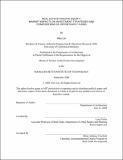| dc.contributor.advisor | Lynn Fisher. | en_US |
| dc.contributor.author | Lin, Alex | en_US |
| dc.contributor.other | Massachusetts Institute of Technology. Center for Real Estate. | en_US |
| dc.date.accessioned | 2010-09-22T15:55:19Z | |
| dc.date.available | 2010-09-22T15:55:19Z | |
| dc.date.copyright | 2008 | en_US |
| dc.date.issued | 2008 | en_US |
| dc.identifier.uri | http://hdl.handle.net/1721.1/58635 | |
| dc.description | Thesis (S.M. in Real Estate Development)--Massachusetts Institute of Technology, Dept. of Architecture, Center for Real Estate, 2008. | en_US |
| dc.description | This electronic version was submitted by the student author. The certified thesis is available in the Institute Archives and Special Collections. | en_US |
| dc.description | Includes bibliographical references (leaves 66-68). | en_US |
| dc.description.abstract | Market forces continually change the landscape of the real estate private equity ("REPE") industry. In the current market, robust capital raising and the emergence of new funds in REPE suggest increasing competition to place capital while the credit crisis has marked the end of an era for cheap debt that was previously used by opportunity funds to enhance returns. Under these changing market conditions, opportunity funds seek to continually deliver above market returns through various investment strategies and composition allocations which have major implications on the risk levels of the funds. This thesis seeks to understand if and how recent market changes have influenced the REPE industry. It identifies the kinds of investment strategies currently being used by opportunistic funds, and in particular, whether the investment compositions of the opportunity fund portfolios are changing in terms of geographic allocation or asset type allocation. The study finds that opportunity funds have been notably impacted by forces of the credit crisis, but not necessarily by increasing competition. While it is not readily apparent whether investment compositions of opportunity funds have changed due to the credit crisis, several global funds are increasing geographic allocations to emerging markets, such as Asia, to enhance returns. The interviewees generally believe that they will continue to deliver the proposed returns without necessarily increasing portfolio risks due to their flexible investment mandate, which allows them to invest in opportunities that are inline with their expertise and experience. | en_US |
| dc.description.abstract | (cont.) In the short term, most funds expect opportunities to arise from distressed sellers. This thesis attempts to shed light on some issues involving REPE investing and represents a first attempt to scratch the surface of opportunistic investment portfolio compositions and strategies. Hopefully, readers will gain insight into the workings of this growing and highly proprietary asset class. | en_US |
| dc.description.statementofresponsibility | by Alex Lin. | en_US |
| dc.format.extent | 58 leaves | en_US |
| dc.language.iso | eng | en_US |
| dc.publisher | Massachusetts Institute of Technology | en_US |
| dc.rights | M.I.T. theses are protected by
copyright. They may be viewed from this source for any purpose, but
reproduction or distribution in any format is prohibited without written
permission. See provided URL for inquiries about permission. | en_US |
| dc.rights.uri | http://dspace.mit.edu/handle/1721.1/7582 | en_US |
| dc.subject | Architecture. | en_US |
| dc.subject | Center for Real Estate. | en_US |
| dc.title | Real estate private equity : market impacts on investment strategies and compositions of opportunity funds | en_US |
| dc.title.alternative | REPE : market impacts on investment strategies and compositions of opportunity funds | en_US |
| dc.type | Thesis | en_US |
| dc.description.degree | S.M.in Real Estate Development | en_US |
| dc.contributor.department | Massachusetts Institute of Technology. Center for Real Estate | en_US |
| dc.contributor.department | Massachusetts Institute of Technology. Department of Architecture | |
| dc.identifier.oclc | 314863553 | en_US |
